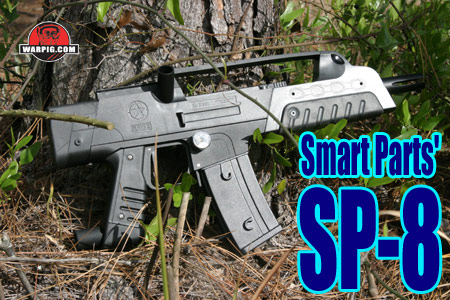  |
|
|
|
|
|
|
  |
|
|
|
|
|
|

What
do you think?
|

SP-8 By Bill Mills - Photos by Dawn Mills - Apr 2006 Testing Overview - How It Works - Disassembly - Testing - Raw Test Data
In addition to hand shooting SP-8 was put through its paces with objective testing, comparing accuracy with the stock barrel to accuracy with a bore matched Freak barrel, checking for velocity consistency at varying rates of fire, and measuring sound output levels.
Firing 30 shots at 1 shot per second yielded an average velocity of 286.8 feet per second, with a high of 301.2 and a low of 271.4. The standard deviation was 8. Further analysis indicated a 95% +/- value of 3 (95% of the shots fired would be within 3 fps of the average.) Cranking up the rate of fire to 12 shots per second, a string of 30 the average velocity shifted to 263.4 feet per second with a high of 293 and a low of 229.2. The standard deviation was 19.8 with a 95% +/- of 8.
A trend not apparent in the summary data showed significantly when charting the velocities of the two shot strings. While the velocity was less stable initially at 12 balls per second than at one, it became more consistent as the shooting progressed, becoming comparable for the last third of the string. The stock barrel was compared to a standard Freak barrel with All American tip and 0.687" paint matched insert, for accuracy, shooting 20 shot groupings from 75 feet, at a rate of one ball per second.
To get a quantifiable measure of how loud it is, the SP-8 was hand fired for 10 shots on the test stand, and sound level measurements were taken from a distance of 10 feet from the muzzle, at an angle of approximately 45 degrees from the line of fire. The peak sound level measured was consistent, averaging 54.8dB.
|
| Copyright © 1992-2019
Corinthian Media Services. WARPIG's webmasters can be reached through our feedback form. All articles and images are copyrighted and may not be redistributed without the written permission of their original creators and Corinthian Media Services. The WARPIG paintball page is a collection of information and pointers to sources from around the internet and other locations. As such, Corinthian Media Services makes no claims to the trustworthiness or reliability of said information. The information contained in, and referenced by WARPIG, should not be used as a substitute for safety information from trained professionals in the paintball industry. |